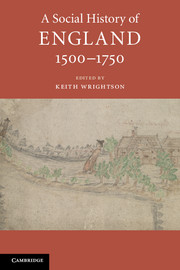Book contents
- Frontmatter
- Contents
- List of Figures
- List of Tables
- List of Contributors
- Acknowledgements
- List of Abbreviations
- Introduction: Framing Early Modern England
- PART I DISCOVERING THE ENGLISH
- PART II CURRENTS OF CHANGE
- PART III SOCIAL IDENTITIES
- 12 ‘Gentlemen’: Remaking the English Ruling Class
- 13 The ‘Middling Sort’: An Emergent Cultural Identity
- 14 The ‘Meaner Sort’: Labouring People and the Poor
- 15 Gender, the Body and Sexuality
- 16 The English and ‘Others’ in England and Beyond
- Coda: History, Time and Social Memory
- Further Reading
- Index
14 - The ‘Meaner Sort’: Labouring People and the Poor
from PART III - SOCIAL IDENTITIES
Published online by Cambridge University Press: 28 May 2018
- Frontmatter
- Contents
- List of Figures
- List of Tables
- List of Contributors
- Acknowledgements
- List of Abbreviations
- Introduction: Framing Early Modern England
- PART I DISCOVERING THE ENGLISH
- PART II CURRENTS OF CHANGE
- PART III SOCIAL IDENTITIES
- 12 ‘Gentlemen’: Remaking the English Ruling Class
- 13 The ‘Middling Sort’: An Emergent Cultural Identity
- 14 The ‘Meaner Sort’: Labouring People and the Poor
- 15 Gender, the Body and Sexuality
- 16 The English and ‘Others’ in England and Beyond
- Coda: History, Time and Social Memory
- Further Reading
- Index
Summary
Who exactly were those whom contemporaries categorised as ‘the meaner sort of people’? These were those people whom educated contemporaries such as William Harrison (1535–93) thought had ‘neither voice nor authoritie in the common wealthe, but are to be ruled and not to rule other’: day labourers, poor husbandmen, artificers and servants. A more statistical account of the bottom of English society was devised by the political arithmetician Gregory King (1648–1712). King classified those who were, in his notorious phrase, ‘decreasing the wealth of the nation’ – by which he meant that their expenditure exceeded their income – into five groups: common seamen, labouring people and outservants, cottagers and paupers, common soldiers, and vagrants. Such people are often grouped together as ‘the labouring poor’ – a term apparently coined by the prolific writer and (failed) businessman Daniel Defoe (1660?–1731). However, that phrase, which only came into general use in the late eighteenth century, should not be used in this period, since it conflates two overlapping social groups, labouring people and the poor, who really should be treated separately.
The key distinguishing feature of all labouring people was that they and their families earned part or all of their living by working for wages (usually money but sometimes wholly or partly in kind). For the majority, work started early in life. Where there was suitable industry, children as young as four could contribute to household income. The Norwich Census of the Poor (1570) listed 330 children and youths aged between four and twenty who worked to supplement household income. Many worked in the city's large textile industry, but a few helped their parents, such as the tinker's son who carried his father's bag. Children could also work in the fields, scaring birds or picking up stones. Most children of the labouring sort would expect to leave home in their mid teens to go into service or apprenticeship; for many, being fed and housed as part of the family of a substantial farmer or middling artisan might well have been the material high point of their working lives. In the seventeenth and eighteenth centuries between a third and a half of all hired agricultural labour was supplied by unmarried ‘servants in husbandry’.
- Type
- Chapter
- Information
- A Social History of England, 1500–1750 , pp. 310 - 329Publisher: Cambridge University PressPrint publication year: 2017
- 2
- Cited by



